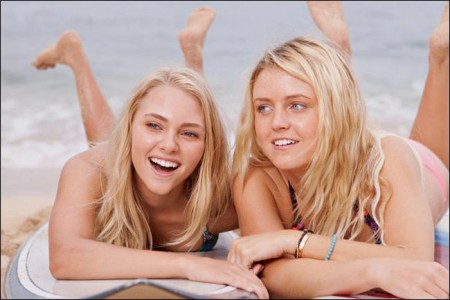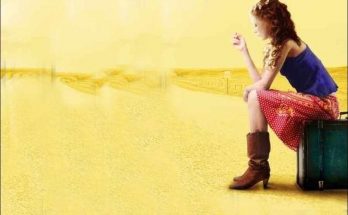Adding to the stirring authenticity of Soul Surfer, Sean McNamara and the filmmaking team shot on location on the North Shores of Oahu and Kauai, the epicenters of Hawaiian big wave surfing, where the ocean is a way of life. Filming took place at such surf hotspots as Makaha, Waimea Bay, Sunset Beach and Turtle Bay Resort – many of the places Bethany has been frequenting since she was old enough to stand up.
The visual focus was not only on the outer elements, however. Equally important was allowing the audience to viscerally experience Bethany’s inner changes. Throughout the production, the filmmakers worked closely with the extended Hamilton family to assure the core of their experiences was captured on the screen. In addition to Bethany herself, Bethany’s parents, Tom and Cheri, her brothers, Tim and Noah, and sister-in-law Becky Baumgartner, who directed the 2007 short documentary film Heart of a Soul Surfer, all spent considerable time on set, ready to answer questions, big or small, about the personal details of their lives. The on-set presence of Hamilton’s surf sponsor Rip Curl, which stood beside her in supporting her dreams, brought in another element of Bethany’s real-world life to the film.
Collaborating with McNamara to capture all the film’s contrasts – the paradisiacal beauty and drama of the Hawaiian ocean, the stormy family emotions and the foundation of love and generosity that turned everything around — was a team that included director of photography John Leonetti, production designer Rusty Smith and costume designer Cathy James.
Leonetti also oversaw the exhilarating surf footage captured by the movie’s second unit, headed by Brian Keaulana and Greg Barnett, the award-winning water team and stunt coordinators behind Blue Crush. “When it came to the surfing, I wanted the audience to get a realistic feel for what it was like for Bethany to be out there,” says McNamara. “We had a fantastic crew who all love and know surfing and they made that possible.”
With cameras mounted on surfboards and jet skis, as well as on land, Keualana and Barnett were focused not only on in-the-moment realism but safety. “We approach water production like risk management,” says Keaulana. “You have to identify all the elements in play and all the hidden dangers — reefs, strong currents, high surfs, cold, wind – and work with them, not against them.” This was especially true on Soul Surfer, because it was vital to McNamara to capture the film’s actors, many of them surf novices, in action on their boards for key sequences in the film. “I felt you had to see Dennis Quaid and Helen Hunt out on the water,” the director explains. “We used professional doubles for the bigger stunts, of course, but having the stars out there really added to the authenticity. The fact that I had such game actors willing to learn and put themselves in that position meant a lot to me. I think they trusted me because they knew how much I love surfing.”
At her request, Bethany did a lot of her own surf stunts, although matching her willowy body with AnnaSophia Robb’s took a variety of camera tricks that play with perspective. “It’s amazing that we were able to match them up so well,” muses McNamara. “They are completely different sizes, and yet, somehow they were such mirrors to each other that it worked.”
Production designer Rusty Smith faced a different kind of challenge, recreating the Hamiltons’ rustic, life-filled North Shore home inside a barren local house. For Bethany’s room, Smith and art director Rosario Provenza created a surf-girl’s ultimate refuge — covering the walls with inspirational pictures and posters, lining the shelves with trophies from surf contests Bethany really won, and filling the floor space with surfboards, workout equipment and even a dog bed (“my real dog Hana gets to play herself in the movie!” notes Hamilton).
At the center of the shoot was one of the most heart-rending and difficult scenes: the shark attack that changed Bethany’s life. Although Bethany never saw the shark, which grabbed her arm from the depths below without warning, the filmmaking team built an exact replica of the 14-foot tiger shark for the production.
For Bethany, it was a shock to see a life-size re-creation of the animal that had done so much damage to her in mere seconds. “It was weird for me to see for the first time how big and scary it really was,” Bethany says. “But I thought it was cool, too, because I also think sharks are really beautiful.”
Leonetti’s team shot the ten-minute scene in 35mm using high-speed Photo-Sonics cameras that roll at 200 frames per second. To further heighten the gripping tension and stark realism of the scene, the shark attack was CGI-enhanced in post-production.
More than 750 visual effects were also employed in post-production to transform AnnaSophia Robb’s left arm into Bethany’s distinctive, at-the-shoulder stump. The film’s visual effects team, anchored by the Los Angeles-based company Engine Room, covered Robb’s arm with a green sleeve throughout filming. They then digitally inserted the stump in every single shot where it was exposed – using a process similar to that used in Forrest Gump to allow Gary Sinise to play the legless Lieutenant Dan Taylor.
Related Link: Read the Full Production Notes for Soul Surfer
Views: 416



